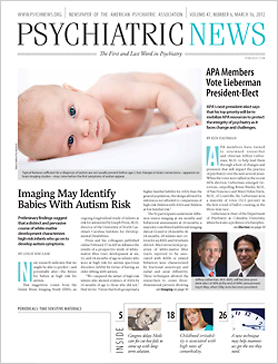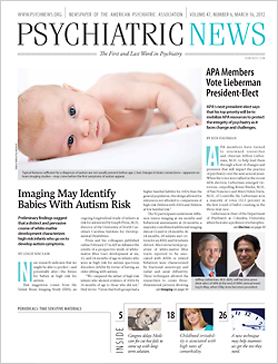New research indicates that we might be able to predict—and potentially alter—the future for babies at high risk for autism.
That suggestion comes from the Infant Brain Imaging Study (IBIS), an ongoing longitudinal study of infants at risk for autism led by Joseph Piven, M.D., director of the University of North Carolina’s Carolina Institute for Developmental Disabilities.
Piven and his colleagues published online February 17 in AJP in Advance the results of a prospective study of white-matter fiber tract development at six, 12, and 24 months of age in infants who were at high risk for autism spectrum disorders (ASDs) by virtue of having an older sibling with autism.
“We compared the subset of high-risk infants who showed evidence of ASDs by 24 months of age to those who did not,” they wrote. “Given that both groups had a higher familial liability for ASDs than the general population, this design allowed for inferences not afforded to comparisons of high-risk children with ASDs and children at low familial risk.”
The 92 participants underwent diffusion tensor imaging at six months and behavioral assessments at 24 months; a majority contributed additional imaging data at 12 and/or 24 months. At 24 months, 28 infants met criteria for an ASD, and 64 infants did not. Microstructural properties of white-matter fiber tracts reported to be associated with ASDs or related behaviors were characterized by fractional anisotropy and radial and axial diffusivity. These techniques allowed the researchers to create three-dimensional pictures showing changes over time in each infant’s white matter.
They found that the fractional anisotropy trajectories for 12 of 15 white-matter fiber tracts differed significantly between the infants who developed ASDs and those who did not.
Development for most fiber tracts in the infants with ASDs was characterized by higher fractional anisotropy values at six months followed by slower change over time relative to infants without ASDs. Thus, by age 24 months, those with ASDs had lower values. “These results suggest that aberrant development of white-matter pathways may precede the manifestation of autistic symptoms in the first year of life,” they concluded.
Autism Foundation Being Laid?
“It would appear that changes in brain connections precede the emergence of the first core symptoms of autism, perhaps laying an altered neural foundation from which autism develops,” lead author Jason Wolff, Ph.D., a postdoctoral fellow at the University of North Carolina, explained to Psychiatric News. “Rather than appearing suddenly, autism unfolds over the first year of life, and these widespread differences in white matter development are part of that story.”
“It’s too early to tell whether the brain-imaging techniques used in the study will be useful in identifying children at risk for ASD in early infancy,” Piven said in a press release about the work from the advocacy organization Autism Speaks. “But the results could guide the development of better tools for predicting the risk that a child will develop ASD and perhaps measuring whether early intervention therapies improve underlying brain biology.”
But how viable is the possibility that earlier recognition of ASD could lead to early intervention or even prevention? Very much so, according to Wolff: “Providing intervention prior to the onset of autism, during a time when the brain is particularly malleable, holds great promise to at-risk children and their families. We’re collectively optimistic that our work and that of others will lead to a new way of thinking about intervention during this critical window of time.”
Earlier Intervention Is the Goal
Study co-author Geri Dawson, Ph.D., chief science officer of Autism Speaks, agreed. “The goal,” she said, “is to intervene as early as possible to prevent or reduce the onset of disabling symptoms.”
IBIS continues to enroll infant siblings into the study at its four clinical sites (University of North Carolina, Chapel Hill; University of Washington, Seattle; Children’s Hospital of Philadelphia; and Washington University, St. Louis). “We are in the process of following up on these initial findings using approaches that incorporate multiple imaging techniques and behavioral measures, as well as combined brain-behavior methods,” said Wolff.
The study was supported by grants from the National Institute of Child Health and Development, Autism Speaks, and the Simons Foundation. Further support was provided by the National Alliance for Medical Image Computing, which is funded by the National Institute of Biomedical Imaging and Bioengineering. The study included data from an Autism Center of Excellence funded by the National Institutes of Health.


